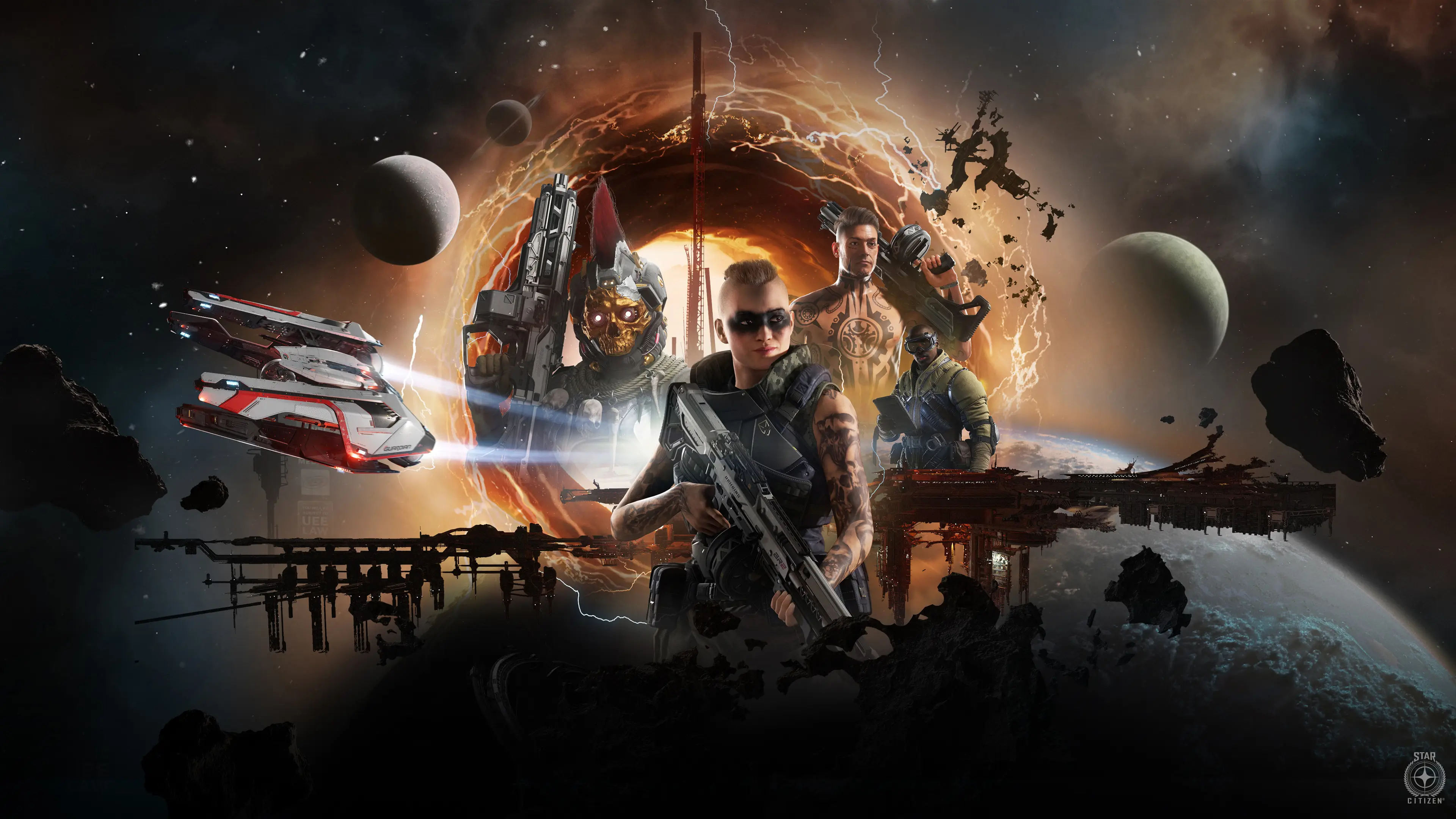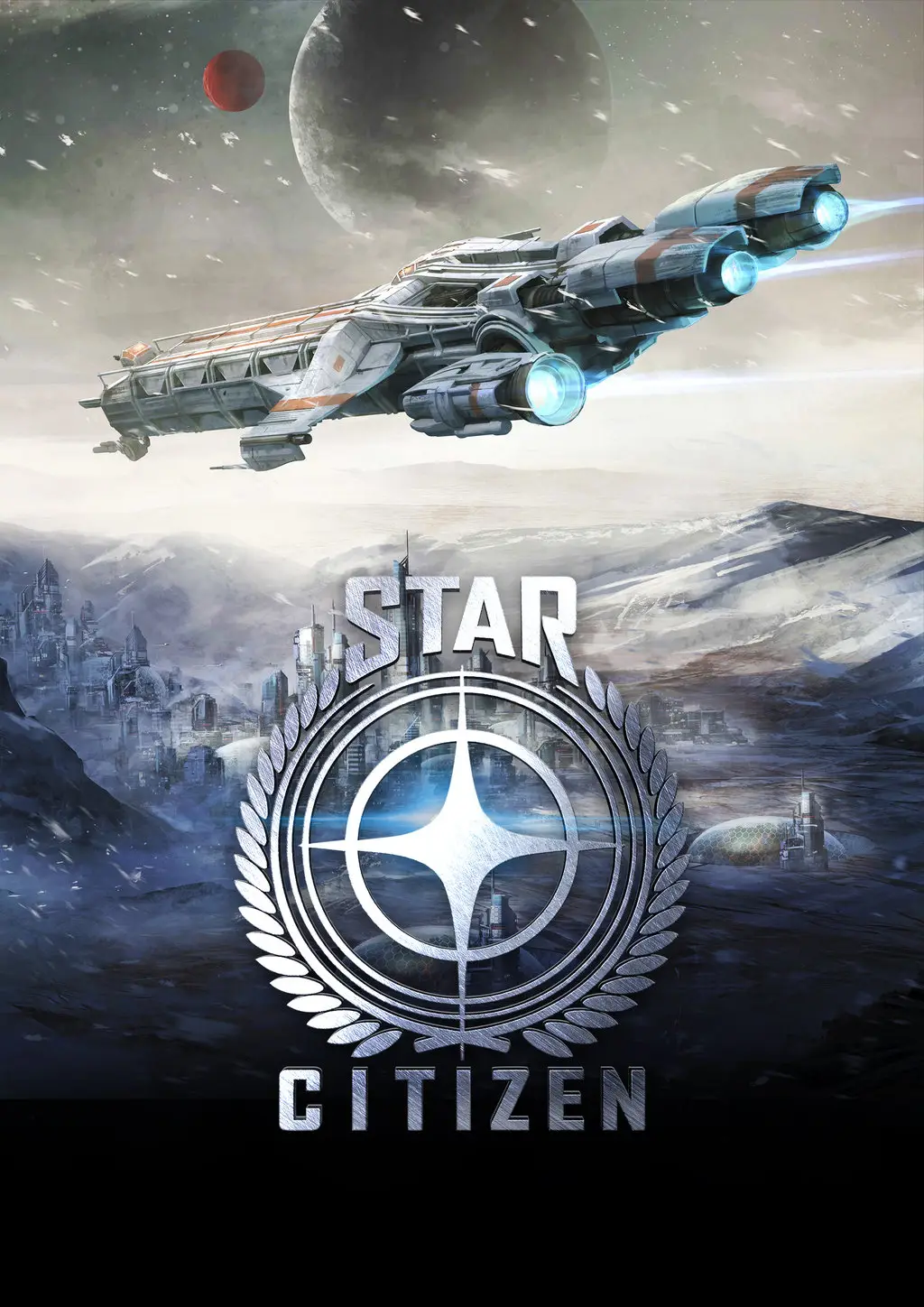If you’re new to Star Citizen, you can start with 50,000 UEC using my link - it helps a lot early on.
You can sign up here.
Now, let’s talk about where Star Citizen is in 2025.
Introduction - scope, ambition, and significance
Star Citizen is a multi-year endeavor to create and build a single, high-fidelity space sim of next-generation vehicle simulation, first-person shooter combat, emergent persistent economy, and single-player narrative campaign. It was first demonstrated to the public in 2012 and was meant to erase the divide between a high-end single-player experience and a dynamic, massively multiplayer universe. It was not destined to be Another Space Game, but a simulation of an interstellar human-scale civilization in all its glory: component-level high-fidelity ship systems, personal stores and realized commodities, NPC economies with supply and demand curves, high-fidelity flight and atmosphere simulation, and single-player narrative content filmed in cinematic quality and under the Squadron 42 banner.
It acquires value from three intersecting needs as the basis of all its decisions regarding design: funding/engagement ambition, design ambition, and technical ambition.
Technical hubris is introduced in the project specifications: true-time high-fidelity rendering of planetary surfaces and interiors, authoritative server design to host millions of dynamic objects in one universe, and a physics model to broker Newtonian space flight, in-atmosphere aerodynamics, and silent vehicle subsystem failure. Wrapping all those pieces into a coherent, playable entity is an engineering challenge of Hercules-like scale. Its designers have wrestled with issues typically one or two orders of magnitude less grand in scale and complexity. Aspiration in design maintains scope creep under control by design, not by default.
The game was designed to allow subtle interaction: players should have been able to navigate the spaceship cockpit, break open crates and trade a variety of physical goods, manage power and fuel supply to systems, and cooperate towards a mission through role or kit selection (pilot, engineer, trader, miner, or gunner). This ambition created a combinatorial explosion of systems needed: terminal and inventory UI/UX, mission systems, internal modular vessels, replaceability of parts, and edge cases of player behavior unbounded. Each design point added to the engineering and content surface to be satisfied. Extrapolation in funding and participation is the third dimension.
Star Citizen blew apart a scale-driven development paradigm that was funded through crowdfunding and adjusted expectations. Rather than doing a small demo and funding the majority through crowd-sourcing, the devs chose sequential public funding - concept ship sales, cosmetics, and early access with openness and interactivity in the way the development was conducted. This route created an unprecedented direct backer-dev relationship, a direct feedback loop powered by livestreams, roadmaps, and monthly reports. It brought new incentives and pressures with it as well: backer expectation, monetization optics, and public exposure affected development pace and shape as much as technological constraint. All three goals combined turned Star Citizen into an instance study of a new, open, and crowd-created portion of a AAA-scale project within an unorthodox publisher model.
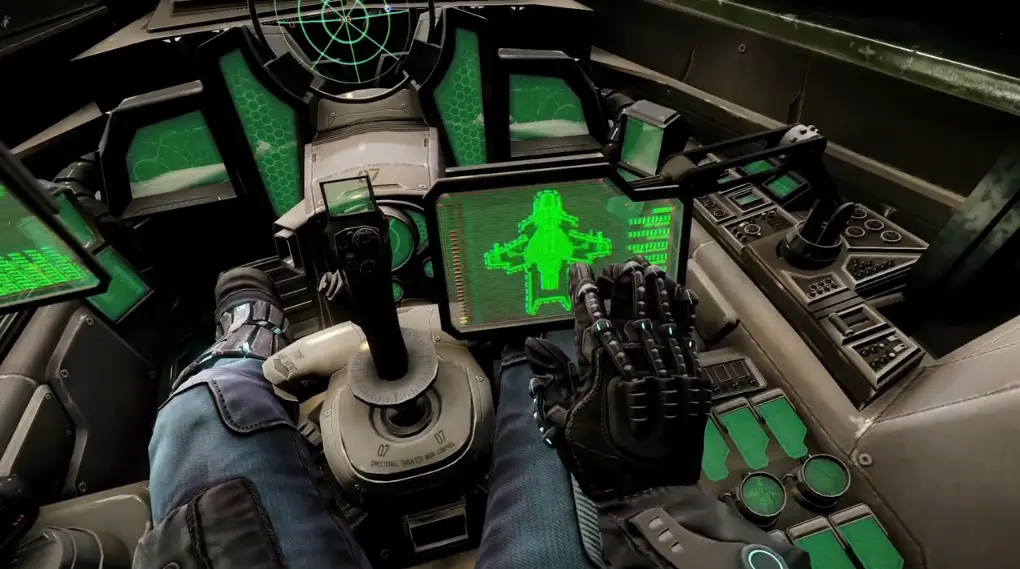
They gave enormous opportunity: an emotionally and financially invested populace, reliable income that addressed sets of near-term commercial pressures, and quick iteration through the mechanics of module-by-module release to subject underlying systems to community stress testing. They gave demanding challenges as well: control of scope, long-term discipline in engineering, community ownership of direction in story, and rational expectations. In order to criticize Star Citizen on its own terms, one then has to remember these aspirations. Nearly all of its critiques - scope creep, delayed production, bugs, or piecemeal releases - are symptoms of an unimaginably big, networked design space.
Furthermore, a few of its most famous qualities - graphical fidelity of ships and interiors, component-level simulation depth, and social enchantment of enthusiast player communities - are emergent side effects of comparable magnitude. That double vision of challenge and possibility best characterizes the project past, and the remainder of these sections. Highlights of the introduction:
- The triple desire characterizes Star Citizen: technical fidelity, design detail, and crowd-funding.
- Ambition allowed a new paradigm of expansion and community but with inherent risk and longer time horizons.
- Any historical review must draw a line between pragmatic engineering considerations and choices in the interests of community, fiscal, and design sovereignty.
Early history (2012–2014): leadership, founding ethos, and crowdfunding
The origins of Star Citizen are not separate from celebrity and career of Chris Roberts, a software programmer most famous for 1990s space-sim classics.
At its announcement in 2012, the game was marketed as both spiritual and technological successor to brutal space sims of yore, brought up to date with contemporary sandbox tastes and massive multiplayer interactivity. The first reaction - a concentrated onslaught of finance through Kickstarter and pre-orders - verified demand for an experience of considerably greater fidelity than existed in the market at the time. The first application of crowdfunding was novel and ambitious. In place of a single Kickstarter to support a prototype, Star Citizen coupled an original Kickstarteranchor with year-over-year open pre-purchase plan: players could purchase ships, concept art, and early access tiers directly from the Roberts Space Industries (RSI) website.
This converted early financial contribution into a flow of direct money that avoided publisher contracts. In reality, what it allowed them to do was ramp headcount and gear rapidly, set up studios in many countries, and commit early to proprietary tech. There were a few short-term organizational implications. Cloud Imperium Games (CIG) was set up as the central development firm, with studios and satellite teams growing up in the United States, the United Kingdom, and elsewhere. Its corporate structure was designed for its ambitions: multiple development teams that could work together on providing rendering, network architecture, ship design, and content.
That level of capability was necessary; the design needed one project to have a shooter, an economy, a flight simulator, cinematic storytelling, ship design tools, and persistent simulation. The company's reaction was to hire accordingly: engineers, artists, designers, and community teams expanded exponentially during those early years. On the product side, early public releases also observed a conservative trend: rather than try to release one monolithic game, the team released prototypic and modular bits. This was a few-driven move. First, releasing individual modules provided the team with immediately playable content that others could playtest and provide feedback on.
Second, modules were proving grounds for subSystems that operated deeply. For example, a combat module might prove flight physics, gunplay, and hit registration without full persistence or mission economies. Third, modular releases created the constant content drop pipeline as means of building a community and attracting continuous direct funding. Communications strategy was one of the signature aspects of those early years. CIG was being more transparent than almost any other company of its scale: regular video posts, public roadmaps, developer streams, and design diaries. Transparency was having a double effect.
It was forging trust and enthusiasm with openly transparent progress proof; at the same time, it was constructing deliverables expectations with tangible content aligning public pledges. The update velocity created cultural expectation among the faithful - endless comment, analysis, meming - that recontextualized any slippage or feature rollback on some imagined timeline. The first couple of years also uncovered the project's tech hotspots. Star Citizen's graphical aspirations required a core engine that could do grand, planet-level render with interior detail. The team began with a commercially licensed high-fidelity engine as a starting point and iterated and refactored portions of the engine rapidly to address some needs.
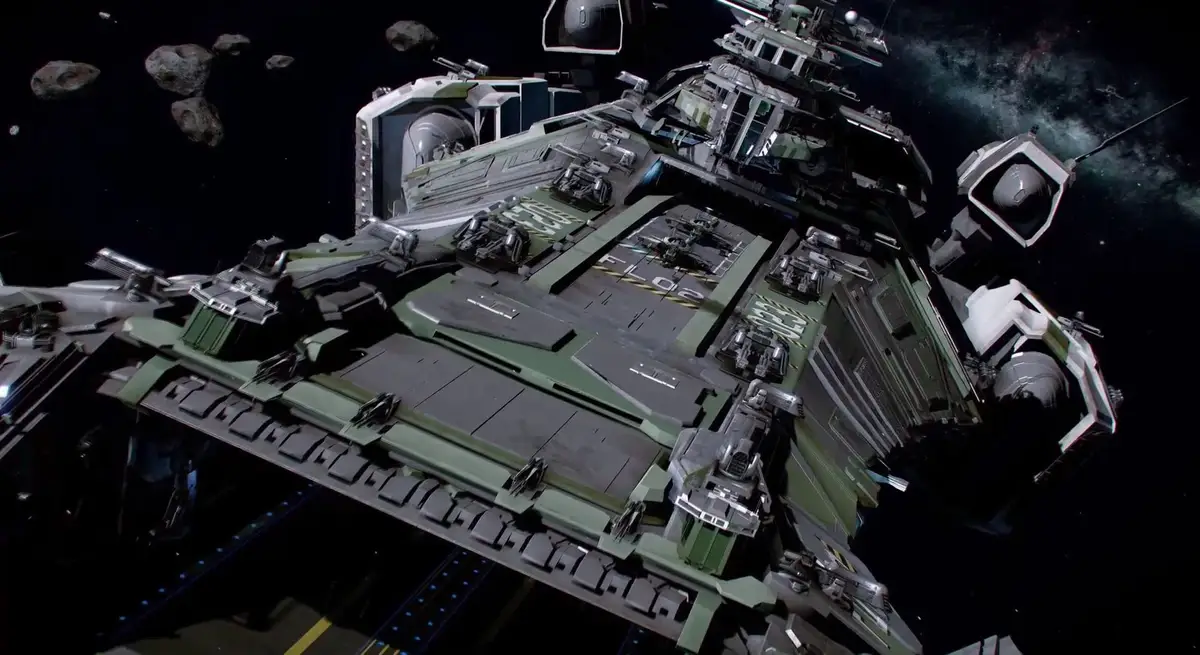
The result was a derivative and custom engine solution: most of middleware had core engine functionality taken from it, but numerous subsystems were re-written or heavily extended to provide a custom pipe for Star Citizen's requirements. That path brought early victory at the expense of cumbersome engineering complexity: a combination of third-party restriction and over-customization in-house introduces more surface area for bugs and integration hell. The revenue model also entailed product compromises that emerged early on. Revenue from cosmetics and ship sales financed development but also commodified futures: fans had bought promises of content and functionality that could not yet be delivered until integration and testing of complex systems were over. Increased scope introduced more to the table of things delivered; fan interest in particular ship types or gameplay elements would quietly but deeply alter design priority.
Such as, bigger capital ships or more sophisticated cargo mechanics would necessitate changes to persistence and server architecture backend. Such additions, paid for in turn by backer purchasing, added to integration cost and accelerated timelines. Public mood at this time see-sawed between hope and dismissive. The majority of supporters had patience with incremental earlier modules as part of a bigger plan scale, enjoying piecemeal anticipation of new modules and ships. Others put down scope, transparency (interim milestone transparency), and long tail of planned features.
Public drama was most when feature announcements and recruitment gained more eyeballs than visible milestones of integration. That fiasco created external pressure: journalists and commentators started questioning milestone integrity, development economics, and legality of compliance - a new degree of sustained criticism for a crowdfunded game. There were two structural facts that defined early years of development. First, up-front cash was married with future redeployed commercial risk: CIG had a long runway but took all product risk. Second, releasing modular, playable segments to a worldwide supporter base provided a live testbed that was significantly different from developmental dynamics.
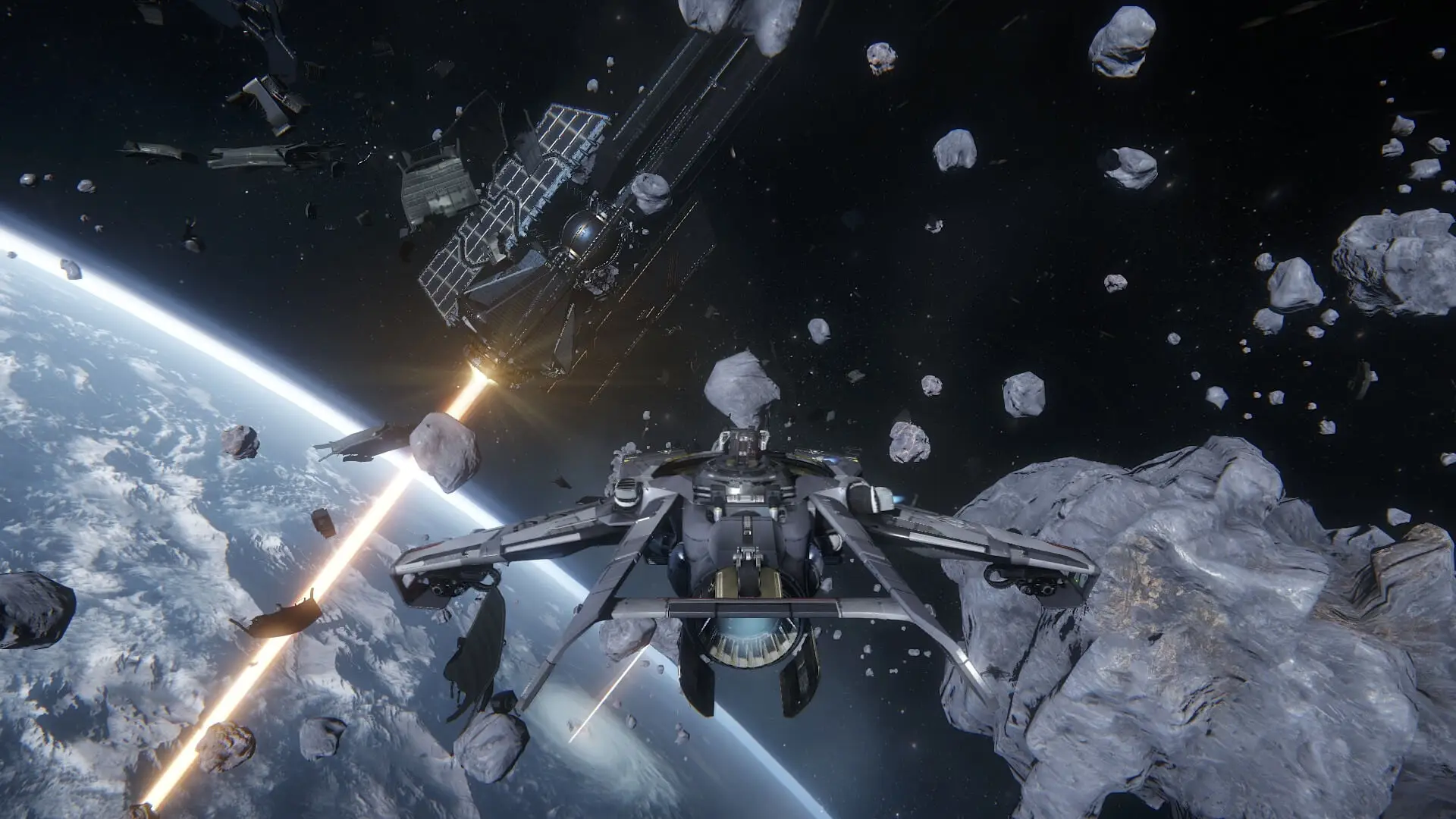
Properties already specified in isolation were open to public, incremental criticism; the criticism gave early quality feedback but invited rework cost because community criticism would usually necessitate larger revisions than the current module could stay within. At this point, the project had earned itself as tech-starved, openly reactive, and commercially unscrambled from typical publishers. This paved the way for the subsequent phase - module releases testing playable systems at large scales, and ironing out technical bases. Key takeaways for 2012–2014:
- It funded scaling rapidly but tied product commitments to early supporter assumptions.
- Expanding organisations enabled simultaneous workstreams but increased integration complexity.
- Early openness encouraged community donation and public comment, and product criticism and improvement affected it.
- Complete customisation was the best-supported engine strategy, high fidelity, and increased integration and support burden.
Modular development and first publicly released modules (2014–2016): hangars, dogfights, and public spaces
Modular strategy became its own development cycle in 2014–2016. Rather than waiting for a unified monolithic game, CIG published individual modules dedicated to core subsystems and provided commercially viable experiences to backers. On the cutting core of this time were three modules: the Hangar Module, Arena Commander, and the Social Module. They were diagnostic and experiential in nature to test rendering pipelines, flight dynamics, combat systems, and social mechanics, and a public demonstration of progress.
Hangar Module - object fidelity, ship inspection, and early commerce
The initial component of the project's vision for ship realism and immersion that was outwardly apparent was the Hangar Module. It placed ships bought for real in-game currency into a computer simulation of a hangar one could explore first person, inspect, test fundamental systems on, and tweak loadouts. The module performed all sorts of precision engineering things:
- It supported high-fidelity interior and asset pipelines for render.
- It supported first-person locomotion and animation systems for detailed interiors.
- It was used for middleware testing of material realism, lighting, and near-field rendering of detailed geometry.
Hangar Module's appeal was visual and tactile initially: to have a highly-detailed spaceship and to zoom in and take a look at its cockpit, its engines, and its hull was instant delight for first-time pledge-holders who had paid money on look-like physical objects. In the outside world, it also gained a saleable display of technological ingenuity; a player could no longer see ships as concept art but as exploitable, usable objects.
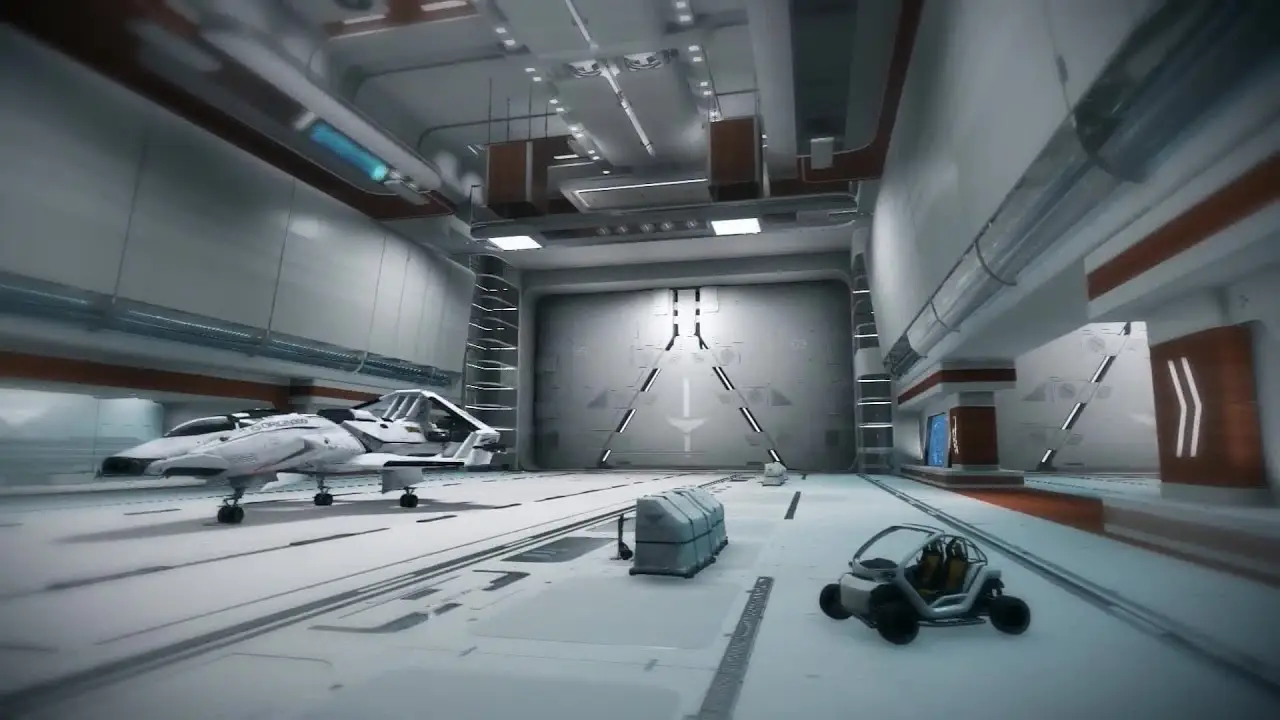
The Hangar Module also uncovered UX expectation and UX performance trade-offs. High-fidelity assets, with high memory requirements, require big rendering and memory budgets; early adopters with lower-hardware experienced frame drops and load ceilings. This cruel reality demanded incremental optimization: streaming asset systems, LOD balancing, and memory budgeting became design requirements. The same engineering realities would subsequently impact the strategy to planetary surfaces and interiors.
Arena Commander flight model, combat and balance technology
Arena Commander served as the laboratory for testing the project's flight and combat. It included flight test modes, dogfight arenas, and short-duration objective games to mimic the flight dynamics of the vehicles, weapon physics, server-authoritative combat decisions, and collision detection. It was both technical validation and play by the community:
- On a theoretical level, it supported networked client physics sync, client interpolation models for clients with high latency, and hit detection across a variety of latency and position error.
- On a design level, it supported iterative fine-tuning of flight behavior, ships' feel, reaction to thrust and torque, and reaction to fluctuating atmosphere.
Public beta versions of Arena Commander exposed the Star Citizen design tension: simulation depth vs. accessibility.
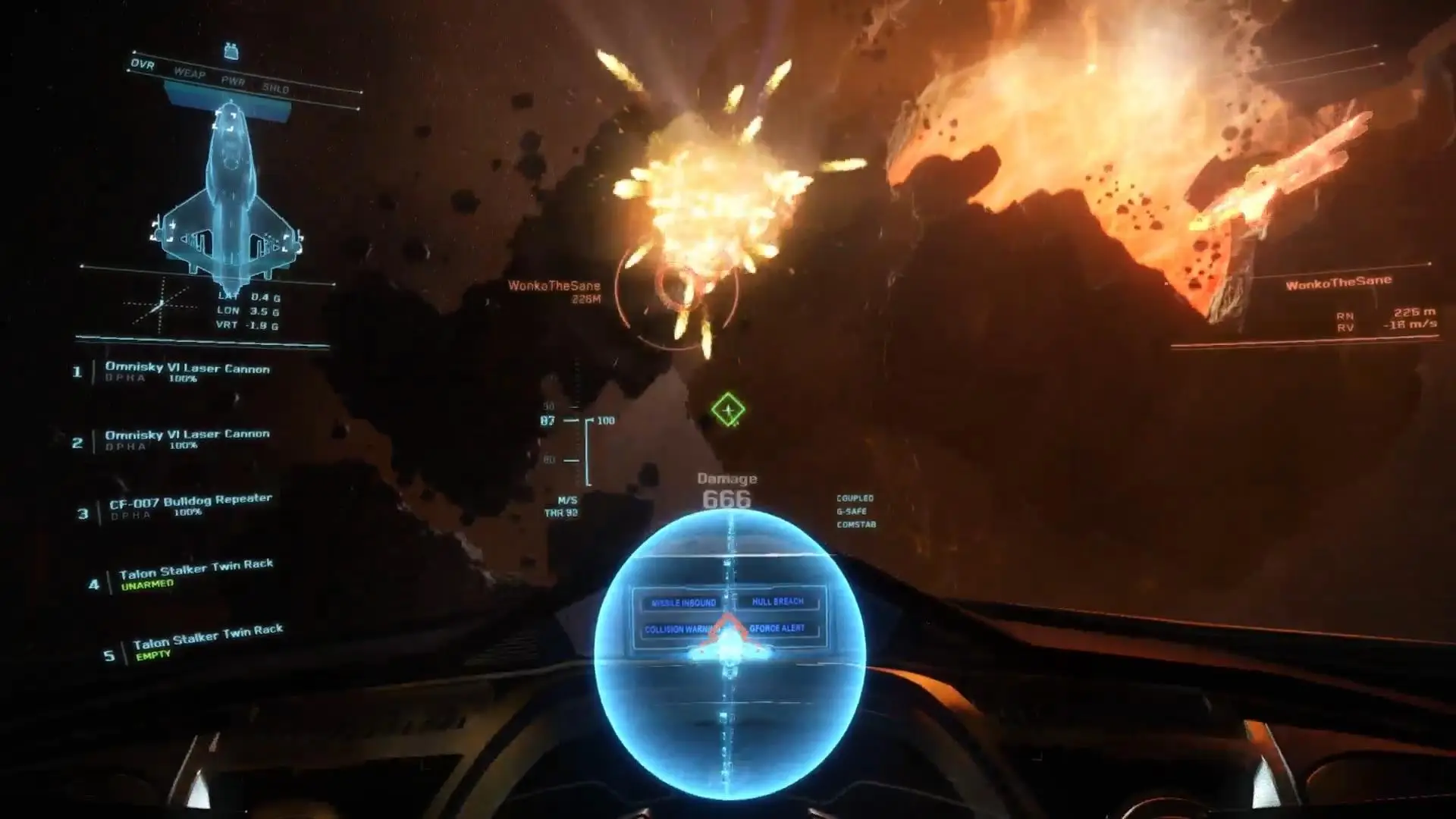
Development flight sims careened wildly between responsiveness-arcade-skewed and inertia simulation realism. Players' response was rapid and intense; players argued control schemes, stability augmentation schemes, and flight envelope settings.
Squabbling turned into real changes to flight code on multiple builds. The module also attracted competitive players, who organized tournaments and streaming wars, with word-of-mouth generating buzz and stress-testing matching and server limits. From a technical point of view, Arena Commander unveiled two age-old issues: deterministic simulation vs. networked latency compensation and sensitivity of complex physics to over-patching. Small physics adjustments were prone to cascade as balance changes and render consonant behaviors of old different and thus needed to be tweaked continuously. The public space in the module ensured that these kinds of regressions became very obvious and sometimes contentious.
Social Module - anchoring the universe in human interaction
The Social Module included open social spaces: taverns, playplaces for gathering, and places where players could get together, trade, and role-play. This experimentation with player interaction, needed NPC action, and developing economies also laid the groundwork for a sustaining community culture: areas of congregation provided players with space where player groups could gather, negotiate missions, and recruit.
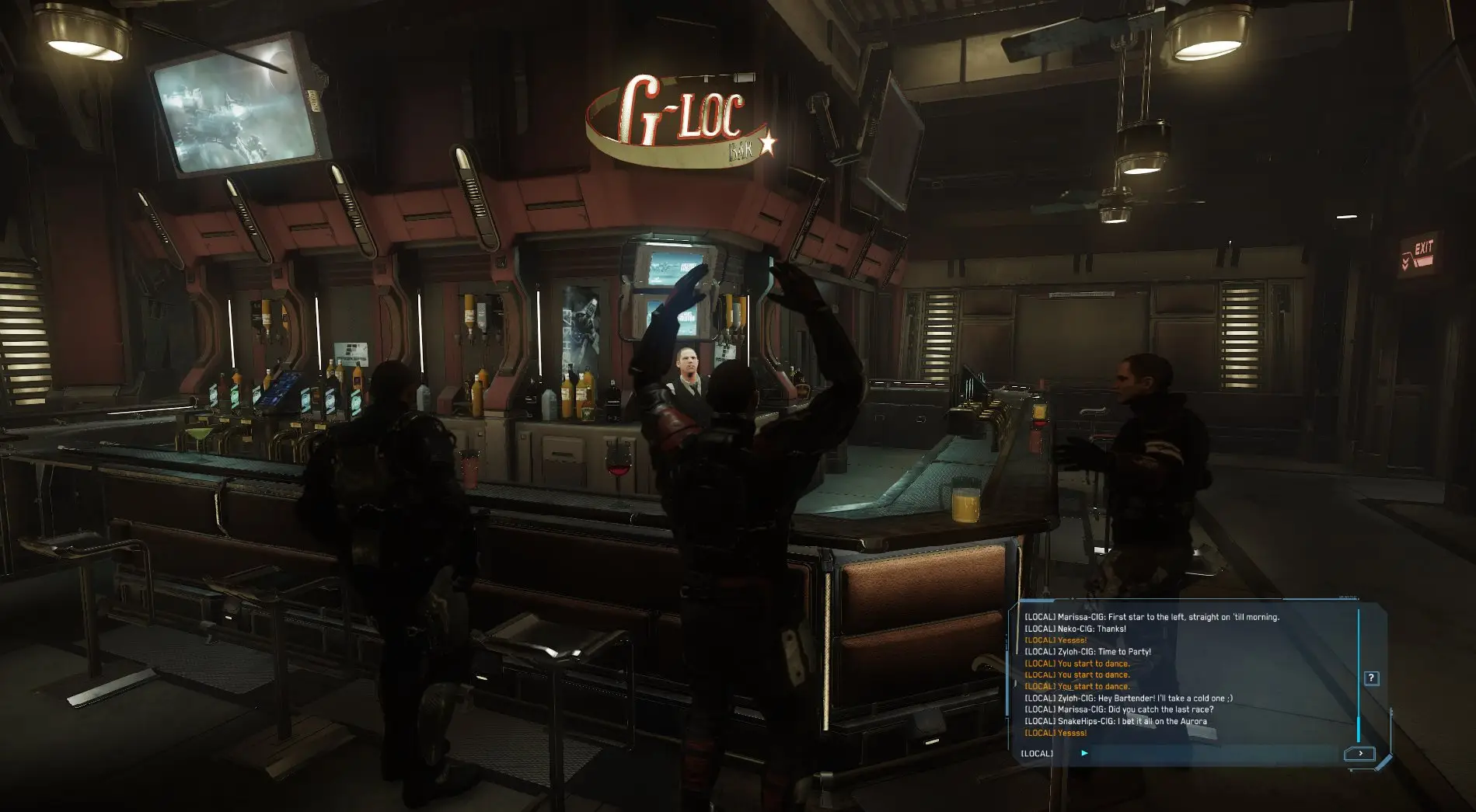
To designers, the Social Module was an Existential Proof: a universe isn't ships and battle but people. Fidelity of social interaction, voice proximity, inventory transfer, and bar banter began to talk about emergent narrative possibilities. To engineers, it was a question of pragmatic considerations: complexity of keeping high numbers of avatars close together, responsiveness of servers, and synchronizing voice and text systems without exploitable behavior.
Advantages of modular approach
Modularity strategy was supported by a series of near-term advantages within the schedule:
- Phased risk reduction. Incremental delivery of subsystems allowed CIG to split and work on significant technology challenges without grouping them to a complete ongoing universe.
- Continuous engagement. Patches and releases involved enthusiasts and provided ongoing funding with quantifiable milestones toward the roadmap.
- Area of testing. Modules were an area of testing and experimentation with edge cases and emergent behavior - i.e., how a weapon will behave in a closed hangar vs. open ground without affecting the project as a whole.
Costs and Tradeoffs
They were tradeoffs whose effect decided the medium term project direction:
- Feature fragmentation. Since they were in separate modules, the game was being played as a collection of isolated things and not as an integrated environment. Fragmentation made it possible for community discussion of lost integrated functions and generated expectations that never dissipated as the game grew in scope.
- Challenge of integration. Each of the modules had been taking user interface, physics parameters, and data structures for itself. Then, efforts at combining modules into a consistent persistent universe entailed considerable rework objects and inventory structures needed to be reconciled, flight dynamics reconciled, and assumptions about networking consolidated.
- Optimization debt. Early modules prioritized surface-level fidelity over rapid, low-overhead streaming. Technical debt was memory and pipeline cruft in streaming, to be eventually paid in order to enable planetary surfaces and long play sessions.
- Public testing cost. Ingesting builds to thousands of active users created a high-visibility testing process, excellent for discovering problems but costly in time spent on hotfixes, agile iteration, and community support.
Supporter culture and community influence
There was certainly a supporter culture among these modules by 2016. They were now well-organized groups, tournament competed in Arena Commander, and socialized. The public alpha stage of the content generated hot streams of criticism: live streamed analysis, community-led whitepapers on performance and balance, and bug reports.
It was a double-edged sword: it also created continuous stress testing and demanded early feedback, but it was also a platform where skepticism could build on itself and where single-point regressions would be able to cause disproportionate outrage in the community.
Renewing the tech stack
Technically, modularity was where pragmatic choice started. Asset tooling evolved gradually: ship interior and character model order construction hardened, and auto-LOD cut iteration time. Network engineering traded more structured, specialist issues - the issue of synchronous position data in short-play Arena Commander matches was one issue, and splitting persistent state in an open world was another issue. Roll-back and interpolation algorithms employed during experiments for combat scenarios would subsequently contribute to persistence and mesh solutions.
Design process and documentation
One less-intuitive but important distinction in this time period, from 2014–2016, was maturity in internal design documentation and inter-disciplinary processes. Since several modules were nearing shipping, design leads needed to document interfaces: how ship data of a component would be stored, how something would need to be serialized and transported from one player's inventory to another, and how mission states were encoded. Those interface commitments lowered downstream integration resistance but did take discipline and occasional retrograde refactoring when previous assumptions no longer held.
Revenue and commercial impact
Module releases considerably augmented the funding model. Cosmetic tie-ins, hangar customization items, and ships still sold and generated revenue and material feature completeness. This loop underwrote the public release schedule from a commercial viewpoint: dollars underwrote headcount growth and new studio openings, both of which subsidized simultaneous development streams. But it also engendered furor around ethical accounting of take and deliver on promise in games, arguments still percolating in the public discourse over the game's model for crowdfunding to this day.
Summary of results for modular phase
At the end of the early modular era (around 2016), Star Citizen had:
- Demonstrated capital ships and character realism in the Hangar Module.
- Iteratively experimented and tried out combat and flight dynamics using Arena Commander.
- Social features and social gravity of open space experimentation using the Social Module.
- Inherited technical debt and process that would need concerted engineering work to integrate in an persistent universe.
- Built a deeply engaged community whose wishes were to move the project forward simultaneously and to create public accountability of feature delivery.
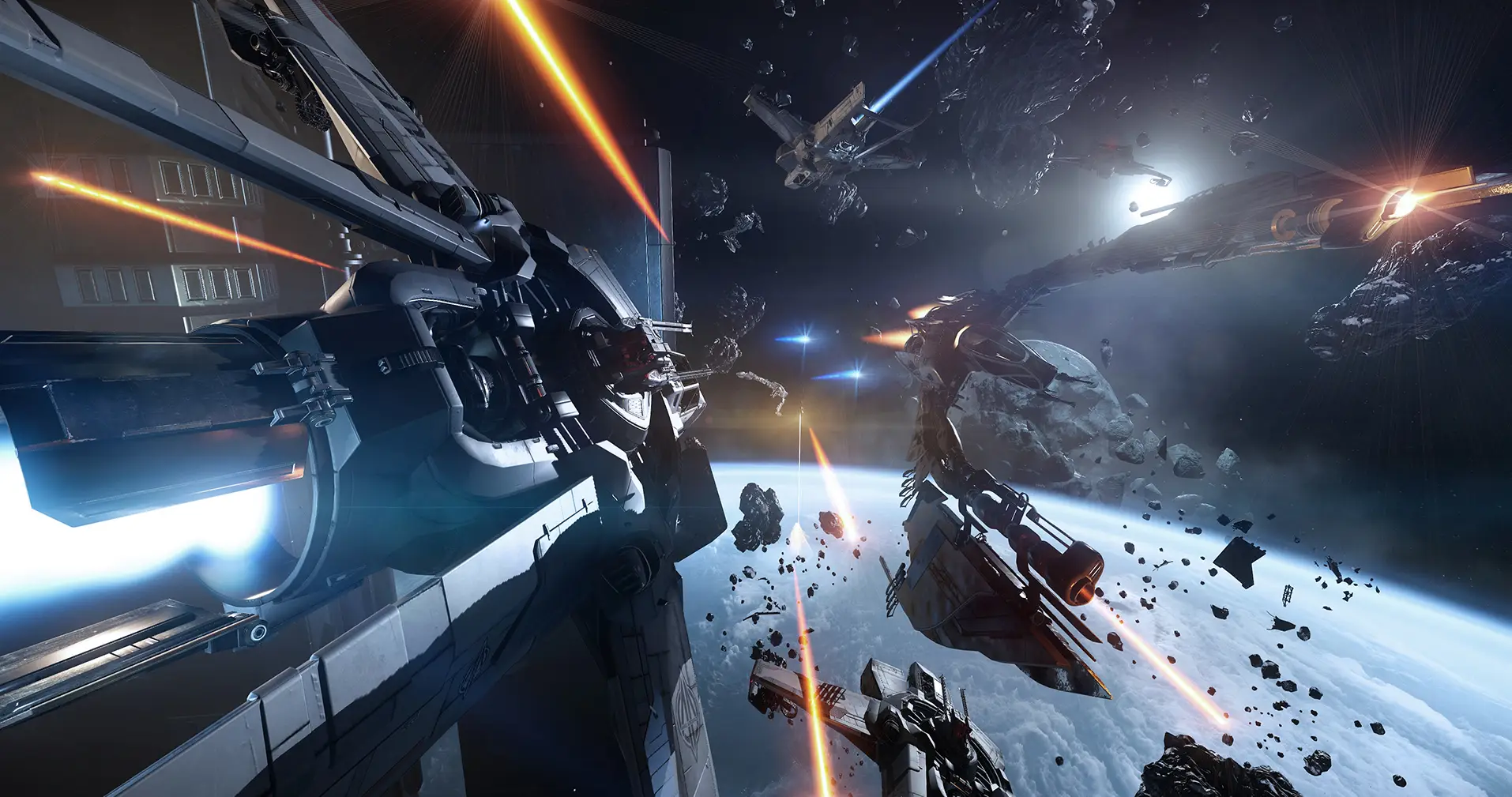
These results provided technical and social foundations for following phases, when the project was scaled out from distributed labs to include those labs within a persistent universe.
Alpha and Beyond Gameplay (2017–2019): Alpha 3.0 and Beyond
2017-2019 were the most visible jump ever on the development arc of Star Citizen. It was when the fragmented, modular test phases - Hangar, Arena Commander, and the Social Module began to coalesce into a persistent, explorable, systemic universe. The touchstone of symbolic meaning was Alpha 3.0, a patch that fanatically reset community expectation and technical reality.
Alpha 3.0: proof of a universe-being-built
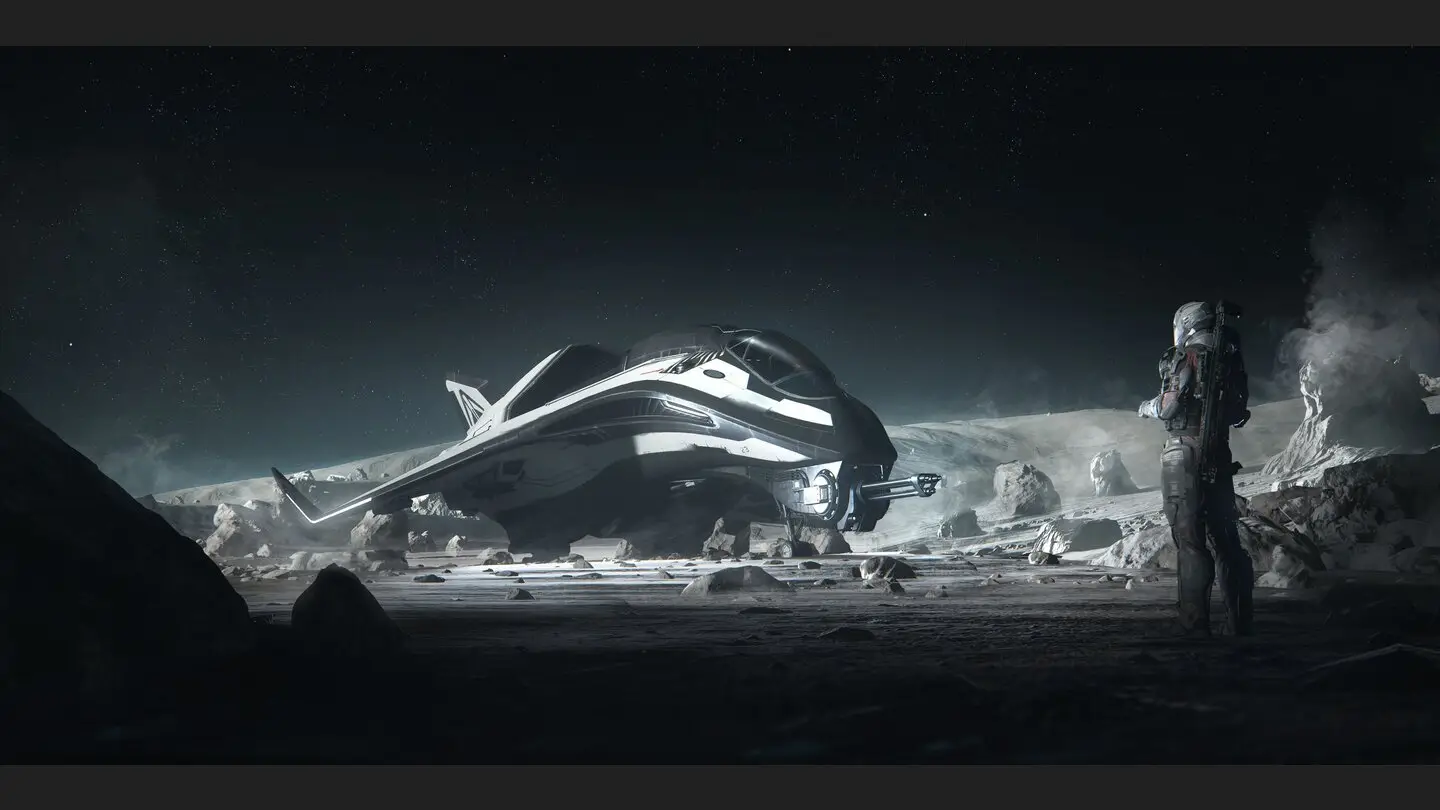
Launched in the fourth quarter of 2017, following months of delays, Alpha 3.0 introduced the first version of planetary landings and surface play. Instead of being confined to orbital space and module hulls, players were able to come down inside planetary masses, leave their ships, and explore outposts scattered over procedurally created terrain. The three Crusader moons (Yela, Cellin, and Daymar) were also included, with minimal outposts and resource nodes. The initial satisfaction of the 2012 pledge: a universe not divided-by-separate-maps, but contiguous one that didn't need loading screens.
Technically, Alpha 3.0 was a milestone in that it required the addition of a planetary tech pipeline: procedural terrain generation, atmospheric scattering, asset streaming, and planetary-scale physics grids. These systems made Star Citizen a functional prototype of a persistent universe.
Gameplay content increased accordingly:
- Cargo mechanics: Players could take delivery missions and transport boxes from outpost to outpost, bringing basic economic gameplay.
- Mission system: Dynamic missioning replaced static missions, towards modular contracts which would scale between game types.
- Mobiglas interface: An in-fiction PDA/UI allowed players to accept missions, inventory management, and in-game system interaction diegetically.
- Trading kiosks: Early market interfaces offered commodity purchase and sale but in primitive form.
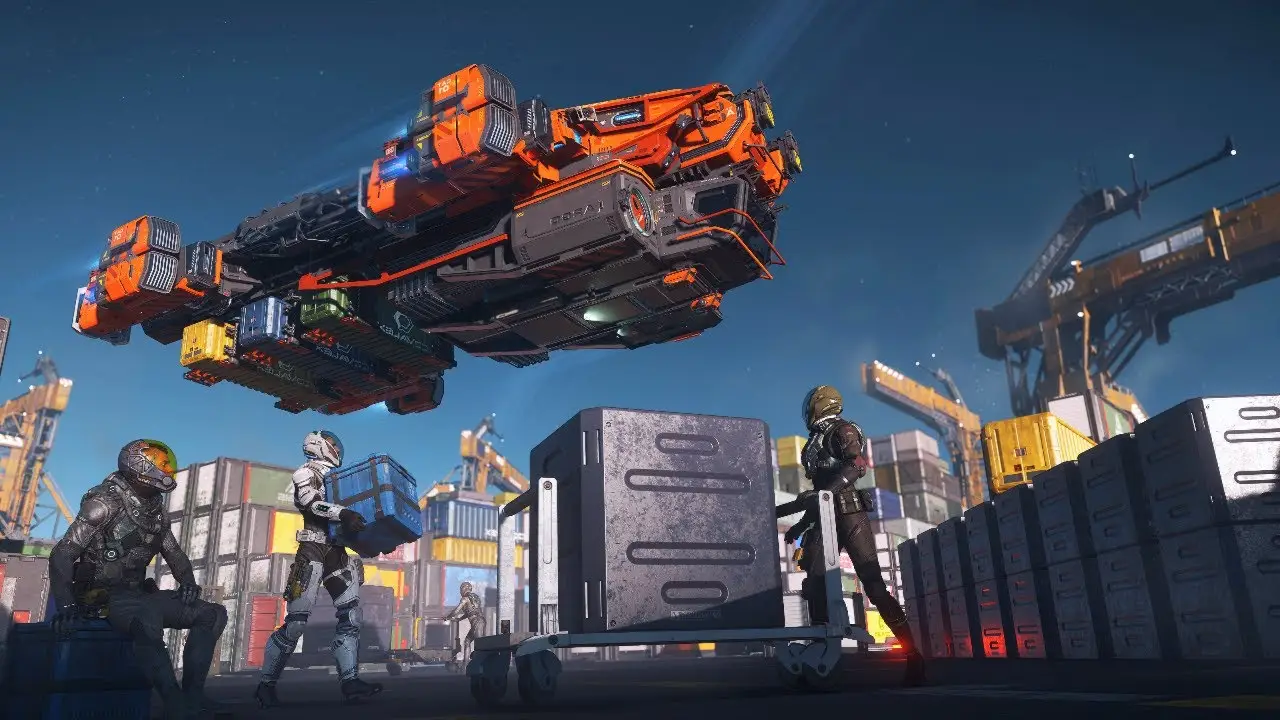
Challenges and instability
Alpha 3.0 also exposed systemic bottlenecks. The game's performance was atrocious, frame rates repeatedly plummeting into single digits even on high-end hardware. Memory leaks, server crashes, and physics desyncing ruled long play sessions. Although new features demonstrated vision, they came with evidence of just how much work needed to be done on optimization.
Subsequent patches: incremental development
After Alpha 3.0, subsequent patches (3.1 to 3.6) polished and developed the game playable:
- 3.1 added further performance improvements and new vessels.
- 3.2 added gameplay for mining with the MISC Prospector and started the resource-harvesting cycle that continues to this day.
- 3.3 added Object Container Streaming (OCS), a fascinating back-end performance enhancement that allowed client systems to download dynamically only those parts of the universe that they required, which improved performance.
- 3.3 also featured Hurston, the initial full-sized planet, with city Lorville, demonstrating ability to add cities through proprietary art and infrastructure.
- 3.4 and 3.5 featured additions: procedural city tech with ArcCorp Area18, female character models, and enhanced flight and FPS systems.
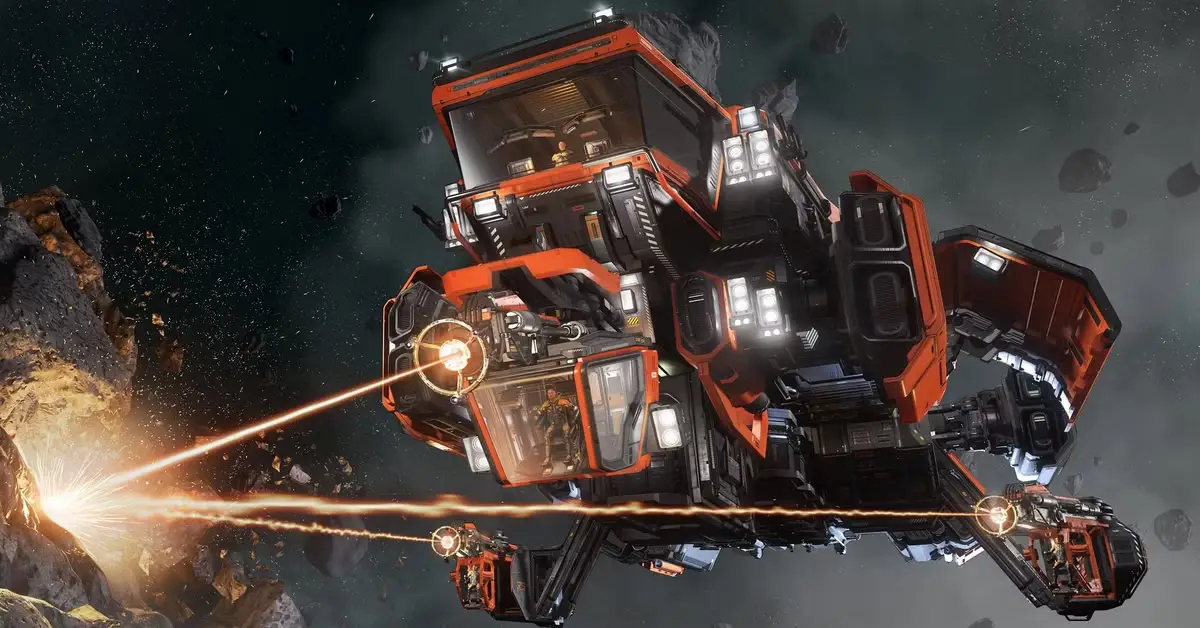
By 2019, the project had grown from a set of several solo standalone modules to a mini-universe of a sort with an inclusive but tiny set of entities. While still with a small scope (single star system, few planets, simple professions), Persistent Universe theory had settled.
Feature Tuning and Expansion (2020–2021): Alpha 3.15 and 3.16
If 2017–2019 was the era of first-scale demonstrations, then 2020–2021 was the era of refinement. Core game systems were added the scope and sheen needed to enable them to reach long-term sustainability. Focus shifted from demonstrating planetary tech and persistence were possible and towards crafting gameplay loops that felt cohesive, risk-reward sane, and long-term exciting.
Medical gameplay and the end of "respawn spam"
Alpha 3.15 introduced one of the largest changes: the medical system. Death was relatively superficial before, with respawning characters not making a significant difference. With 3.15, injury states, medical devices, and hospitals were fundamental game design. Characters could be incapacitated rather than being killed outright, restored by medical devices or hospitalized. This provided emergent game roles (combatives, hospital ship staff) and made sense of combat encounters.
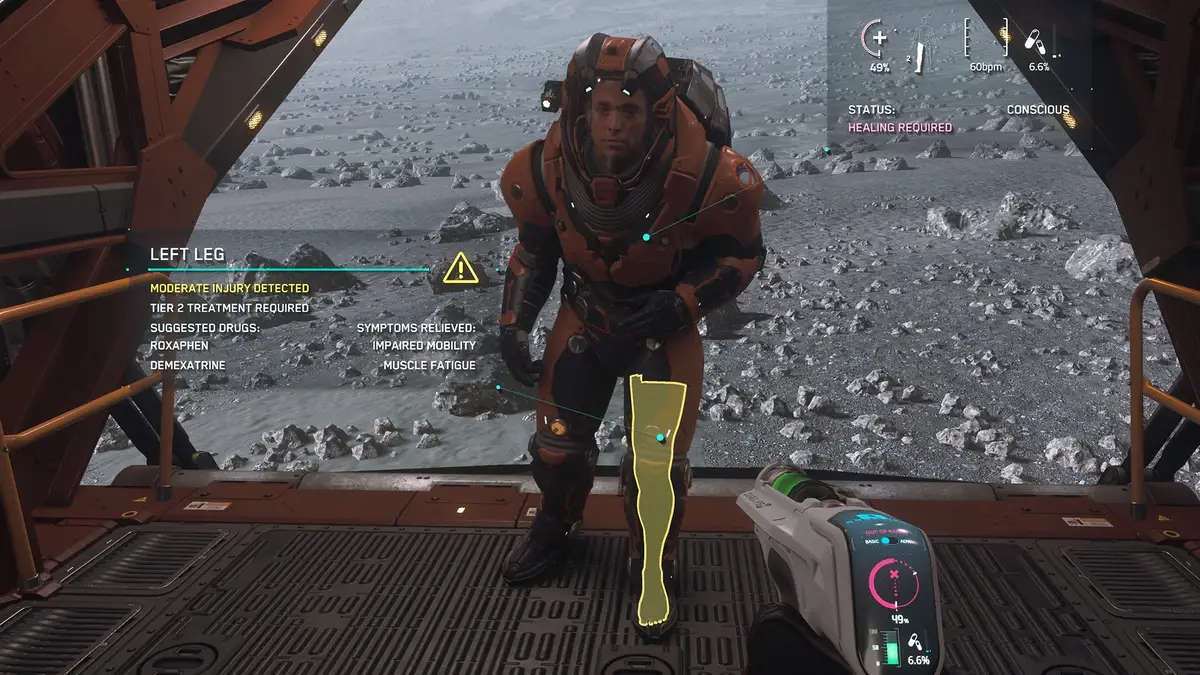
The Cutlass Red and later Apollo ships represented this design shift, medicine-on-the-move. For the first time, Star Citizen gameplay demanded coordinated logistics around injury and death, a step toward persistence and consequence.
Physicalized inventory
In addition to the medical mechanics, Alpha 3.15 also had a physical inventory system. No more unlimited "magic backpacks," players had to navigate in space in personal equipment, ships, and external containers. Inventory was lost upon death, introducing risk to valuable missions. This shift had a permanent impact: it brought preparation and logistics into gameplay and embraced real-world risk for exploration and combat.
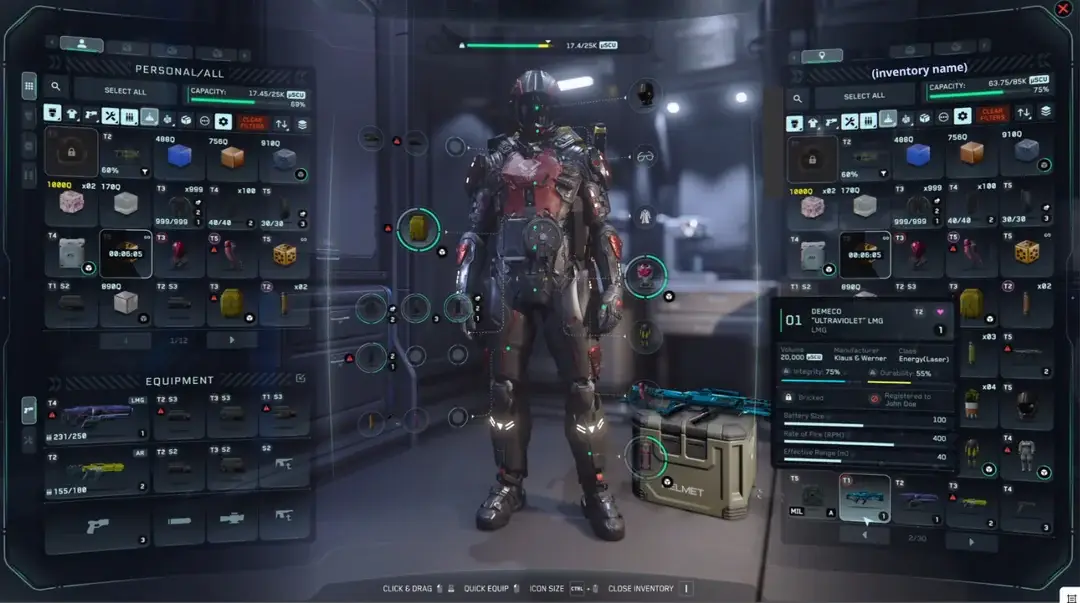
Personal and social hubs
Patch 3.16 revealed the hospital facilities and allocated all the large landing zones to the specialist medical centers. The play of law enforcement was also enhanced, and the missions were linked with interdiction and increased AI patrols. Small quality-of-life tweaks and event content (e.g., XenoThreat, Jumptown rework) cemented the feasibility of cyclical events with huge community participation.
Technological foundations
Backend development was also seen during 2020–2021. iCache, a technology to cache items, was experimented with to cache inventories, ship states, and world objects outside of the server sessions. This was a precursor to complete server meshing, when the universe would be shared across multiple server nodes.
Public opinion split here. Some of its added depth of systems were greeted by many as a blessing in that they gave evidence that Star Citizen was maturing beyond the tech demo roots. Others were dismayed at the cost of pursuing accessibility, the game was harder, punishing the innocent. But even that hardness was true to the original vision: a living universe where consequence would count.
By the end of 2021, Star Citizen had solidified itself into a loop-patterned cycle whose loops combat, mining, trading, medical, and events were able to support play sessions that lasted for hours.
Permanent Universe and Technological Developments (2022–2023): Server Meshing and Long-Term Persistence
The 2022 and 2023 were dedicated to fixing the root scaling issue: how to transition from single-shard design with hard player caps to a seriously persistent universe with dynamic populations. The solutions that were looked for were server meshing and Long-Term Persistence (LTP).
Server meshing: the holy grail of scalability
Classic MMOs shard players into distinct copies, inhibiting interaction and shattering the illusion of one shared single universe. Star Citizen attempted to bypass that, one shard per area so thousands of players could communicate with one another without issue. To get to that level of complexity, server meshing was used to allocate proxy servers to proxy areas of the universe dynamically. One server would be simulating between-planets deep space, one would simulate orbital space, and another would simulate planetary surface. The players would be softly shifted from server to server.
Before full meshing, static server meshing prototypes were tried. These showed that simulation breaking was feasible but shards that were persistent were an engineering problem beyond the imagination. Networking protocols, entity authority, and replication layers needed to be re-engineered.
Replication layer and iCache
Supported by the intermix of servers was the replication layer, state management still at its core, and iCache, storing persistant state of all of the universe. Together, these systems kept ships, cargo, and personal belongings where players had left them last, not crashing and remaining logged off. This laid the groundwork for a true economy and long-term ownership.
Gameplay impact
Long-Term Persistence (LTP) actually changed the way individuals played. Before LTP, wipes and resets were the routine; progress was transient. With LTP in effect, progress (cash, ships, gear) began sticking from patch to patch, and that reinforced investment. That stickiness added to the economy more solid economic activity, emergent logistics, and player-owned organizations to make their riches worth taking seriously.
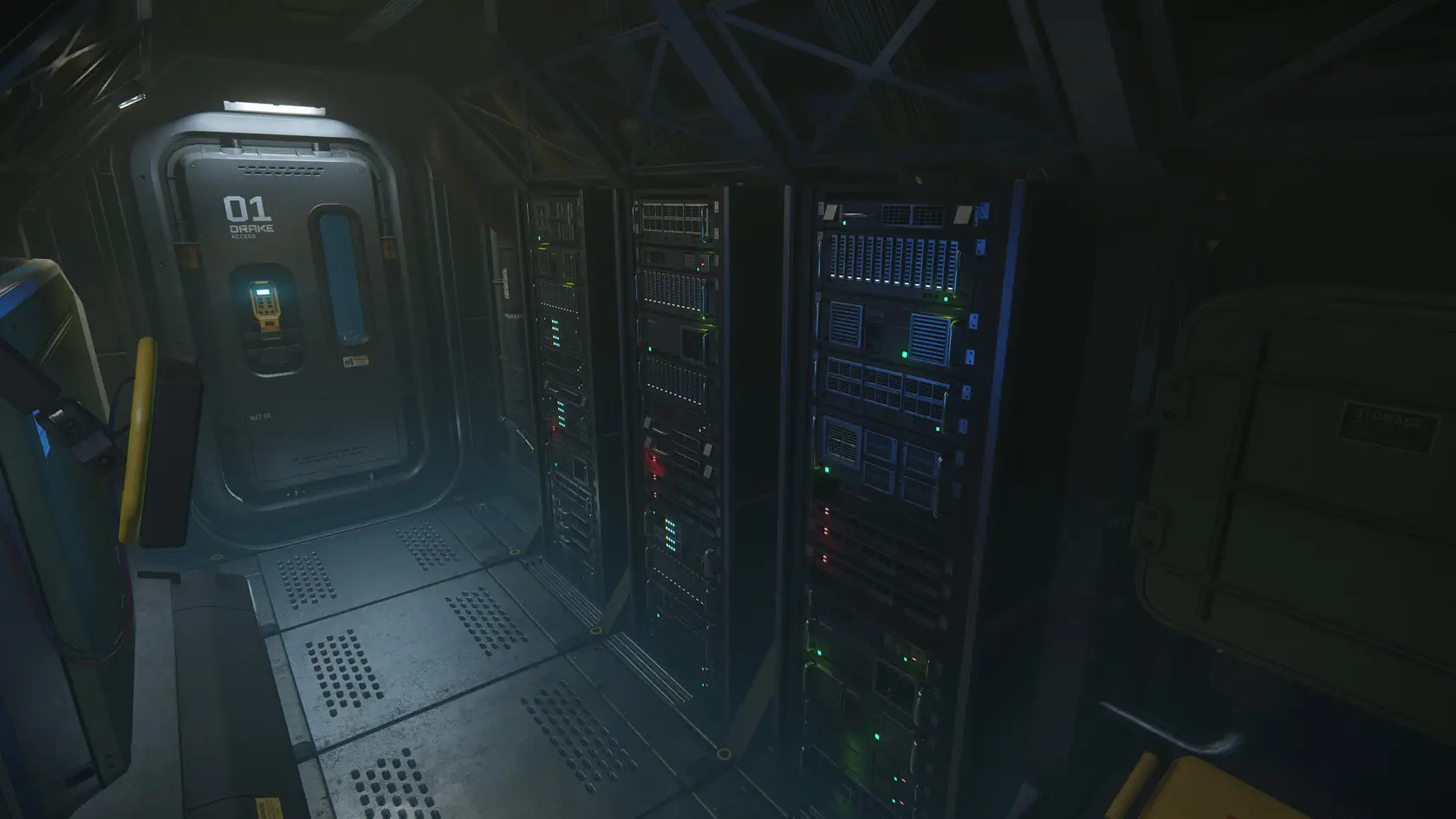
Community and events
Dynamic events were more crucial at this stage. XenoThreat, Nine Tails Lockdown, and Jumptown drug-running events proved that the game could be capable of server-based events involving player involvement and competition. Such events stretched technology and community systems to their breaking points, simulating conditions that future full-scale wars or economic depressions will mirror.
Progress and skepticism
By December 2023, Star Citizen had done good faith work on its solution to the scalability issue. However, doubts remained. Server meshing was still on hold, and few believed the tech solution would scale to the promised "millions of players." However, the addition of LTP, dynamic events, and incremental optimisations gave backers tangible proof that persistence was no longer in theory.
Alpha 4.0 and the New Star Citizen Era (2024–2025): Pyro, Jump Points, and Opening Up Horizons
If 2022–2023 had seen the year of backend breakthroughs, 2024–2025 had been the inaugural open content revolution of Star Citizen. The decade-plus threatened Alpha 4.0 patch, a long-promised one, was the symbolic horizon. It introduced the second star system, Pyro, and with it the principle of jump point travel, advancing the game from single-system prototype to first glimmerings of a multi-system universe.
Pyro system: a dangerous contrast
Where Stanton was a fairly predictable corporation-governed system, Pyro was intended to be poor and lawless. Its stations and planets suffered from derelict infrastructure, piracy, and survivalist gameplay. Pyro's fiction showed it to be a fallen system where the UEE abandoned and criminal organizations filled in the power vacuum. This provided Star Citizen something to contrast Stanton against: where Stanton was regulation and commerce, Pyro was risk, threat, and emergent PvP.
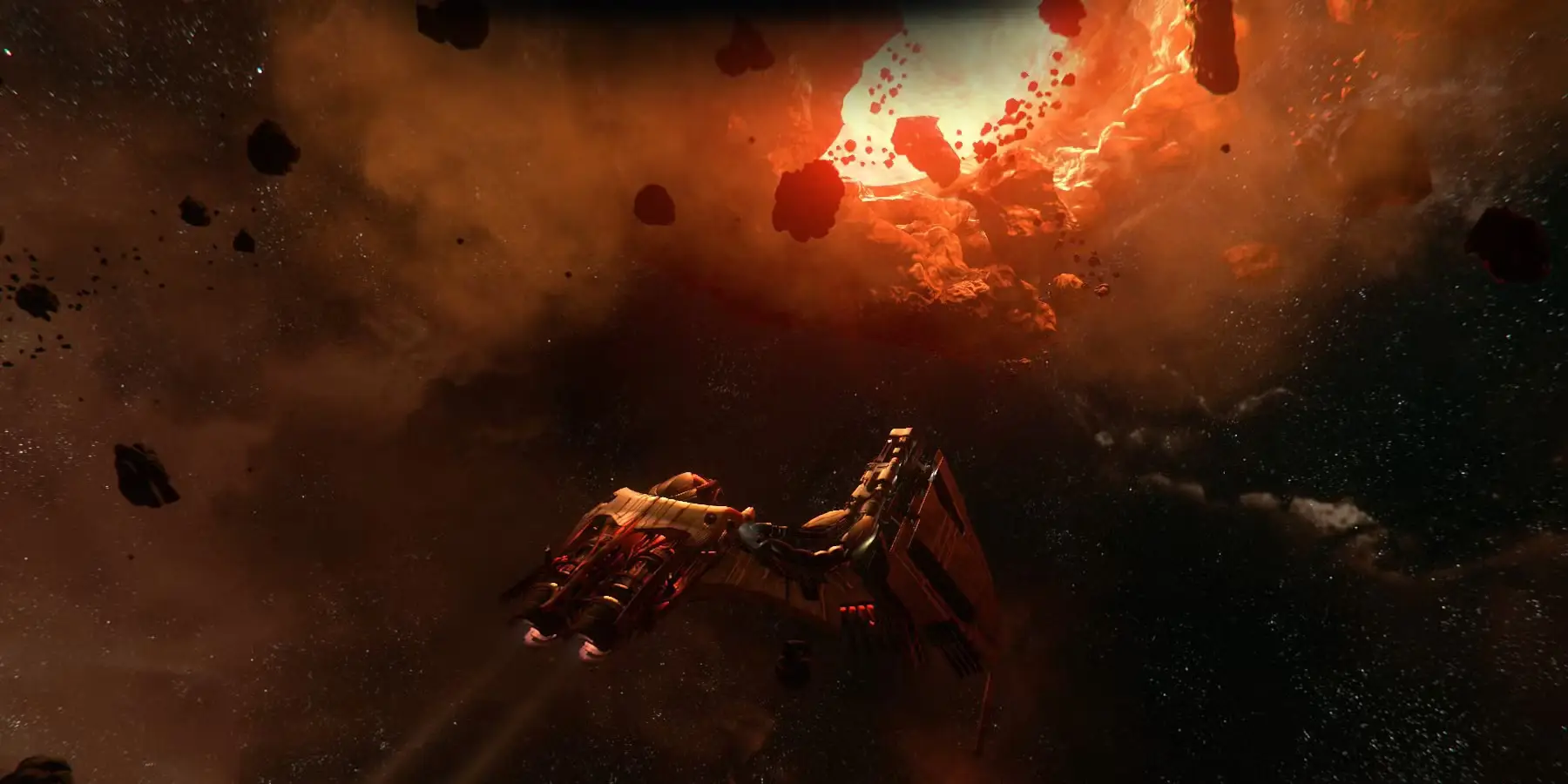
For the players, Pyro introduced:
- Logistics survival mechanics: Rationing of fuel, access to services, and dangers posed by the environment made logistics applicable. Charging headlong into Pyro unarmed might strand players.
- Combat encounters by faction affiliation: Crews of pirate ships dominated space, so miners and traders convoyed or employed escorts.
- Abandoned ruins and colonies: These lent discovery and FPS mission value, with environmental narrative supported by discovery of treasure.
Jump points: intersystem travel in the real world
Pyro-Stanton travel was made possible by a jump point, a wormhole-like tunnel traversed by players in real-time. Pilot skill was demanded by load screens, jump points. Ships were stabilized by players through nasty tunnels of energy, dangerously susceptible to damage or destruction if they erred. This mechanic reinforced Star Citizen's commitment to skill-based travel at the cost of automation.
Jump points were strategic bottlenecks as well. Camp or hold a jump entrance was meta-game, and traveling between systems was politicized and economically motivated.
Re-working 4.0's gameplay
With the exception of Pyro, Alpha 4.0 was justified to have uncomplicated systems in order to be able to handle the scale of a multi-system universe:
- Streaming improvements that persisted: Since the replication layer and iCache were fully integrated, players' inventory, ships, and world state all persisted reliably.
- Balancing the economy: Mining, salvage, and trading were balanced to allow new flows of resources between Pyro and Stanton. Over-deficit in Pyro inflated commodity prices, and high-risk, high-reward gameplay was promoted.
- New vessels and positions: New vessels like the Drake Corsair, Anvil Liberator, and industrial salvagers included logistics and fleet support professions.
4.0 was a psychological benchmark. For supporters who had waited over ten years, adding a second system sanctioned the project's ability to scale both horizontally and vertically, beyond proof-of-concept. While still short of the "100 systems" vow, Pyro's debut meant that Star Citizen could scale both horizontally and vertically.
Player Experience and Community Dynamics in the Persistent Universe
In 2025, Star Citizen was no longer a hobbyist toy tech demo, but a living sandbox where emergent gameplay behavior was the source of the universe's personality. Interactions between technical subsystems, economic feedback mechanisms, and player organizations (orgs) created a meta-level of play that could not be reduced to any particular patch note.
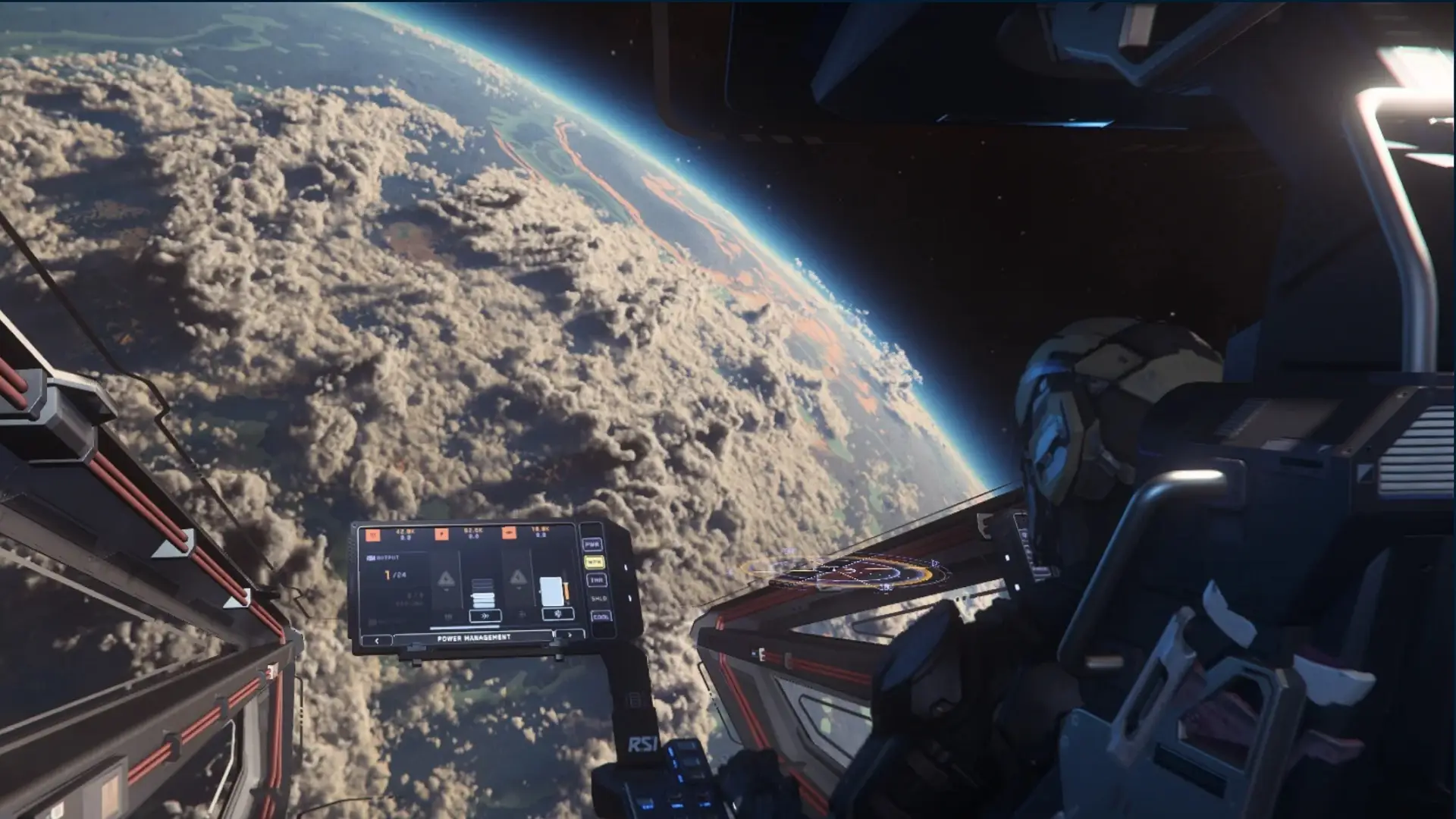
Social structures and organizations
The basis of life in communities were orgs made up of players. They were tiny trade guilds or behemoth megacorps with thousands of members. Each org served a niche: piracy, logistics, mining, exploration, military contracting, essentially serving the role of NPC factions elsewhere in MMOs. With resolve ensuring success long-term value, orgs turned into proto-states, with fleets, supply chains, and diplomacy.
Emergent economy and logistics
The economy, while not yet dynamic, already exhibited emergent behavior grounded in scarcity and risk. To move ore from Pyro to Stanton, for example, required convoy planning, escorting contracts, and staging for fuel pickups. Inadequate coordination can result in ambushes and therefore real money loss. Individuals started to write logistics spreadsheets, route calculators, and insurance policies in orgs, mimicking actual supply chain management.
Event culture
CIG's event series (e.g., XenoThreat, Siege of Orison, Jumptown) were community cultural reference points. Player content was overshadowed by player-organized events, though. Pirate jump point sieges, player-organized moon races between moons, and org war built the PU's dynamic, player-authored history. They flowed through forums and streams, building Star Citizen game- and community-crafted narrative.
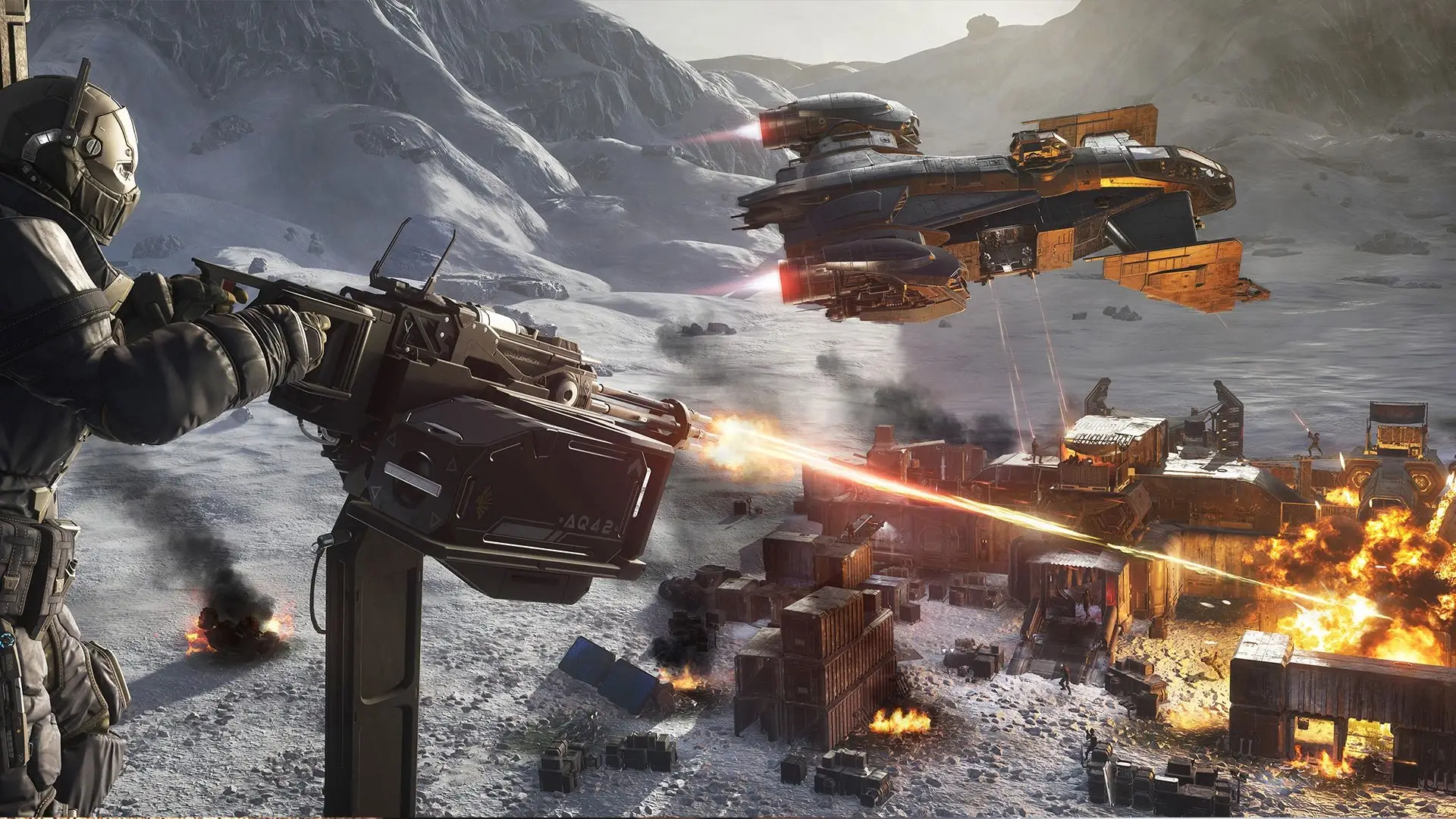
Accessibility and onboarding
Meanwhile, onboarding was a notorious barrier. Control complexity, system depth, and harsh penalty (death, item loss, ship destruction) intimidated new players. Game community-authored tutorials, mentorship initiatives, and guide organizations evolved into an offshoot, cementing the game's reputation as immersive but challenging.
Roleplay and immersion
There was a vast roleplaying subculture that thrived in the game's diegetic reality. Roleplayers used persistent worlds (cities, outposts, ships), interactive UI (Mobiglas, in-game terminals) with persistence to create a theater for roleplay and storytelling with the PU. The majority of them had in-fiction news programs, pirate radio, or mercenary jobs to add to the public experience.
Future Perspective and Greatest Challenges
As of 2025, Star Citizen had unquestionably become a playable, though still unfinished, idea for an MMO of spacefaring unlike any other. And yet the game continued on still in this contradictory state: simultaneously a revolutionary sandbox and a forever unfinished product.
Achievements
- A playable multi-system universe (Stanton + Pyro) with planetary landings that are smooth.
- Core gameplay loops (mining, trading, salvage, medical, logistics, exploration) integrated entirely with persistence.
- Server mesh and replication layer that gives the first flavor of scaleability at large scales.
- Good set of organizations, events, and emergent gameplay.
Challenges
- Scale vs. delivery: It is still an elephant task to scale to hundreds of systems. Pyro took nearly a decade to arrive; scaling that across the roadmap brings existence uncertainty.
- Optimization: Performance remains intermittent. OCS, iCache, and server meshing assisted with stability but even spec-heavy machines remain prone to being clogged by massive fleet battles or congested cities.
- Content cadence: CIG still struggles to balance backend technical development vs. providing new gameplay. Players wildly alternate between euphoria (new content) and rage (delays, bugs, wipes).
- Retention of new players: Learning curve keeps it out of mass adoption. Casual players will be driven off without better tutorials and simplified UI.
- Star Citizen vs. Squadron 42: Single-player campaign not yet released. Its absence has been a thorn in the side years ago.
The road ahead
Optimists respond to the criticisms of server meshing, persistence, and Pyro accomplished, the stage is set for explosive growth. After the tech pillars are stable, content pipelines (new systems, jobs, storytelling paths) can be pushed. Pessimists respond that every milestone accretes new dependency and complexity to guarantee delay as the norm.
In addition to game production, the project is marked by frequent off-game activity. The annual conventions such as CitizenCon, in addition to Bar Citizen events worldwide, are where developers report on progress, disclose roadmaps, and show technology milestones. These are what highlight the cooperative and interactive nature of development and public involvement and constitute Star Citizen as much as a game as an open public cooperative venture between studio and participants.
Ultimately, Star Citizen in 2025 is best described as a living prototype at scale. It already demonstrated the feasibility of anything previously deemed impossible, seamless landing on planets, player-driven economies, server-global events, but it still has a couple of years, perhaps even decades, to its original 100 star systems target. Its beauty is that it exists in two forms at once: an MMO to-play by hardcore fans, and a ever-changing development experiment witnessed by the general gaming community.
New players can join via referral links and receive in-game credits as a starting bonus. Using this referral link provides 50,000 UEC, which can be used for ships, gear, and early exploration within the Persistent Universe.
⠀
This site is not endorsed by or affiliated with the Cloud Imperium or Roberts Space Industries group of companies. All game content and materials are copyright Cloud Imperium Rights LLC and Cloud Imperium Rights Ltd.. Star Citizen®, Squadron 42®, Roberts Space Industries®, and Cloud Imperium® are registered trademarks of Cloud Imperium Rights LLC. All rights reserved.
